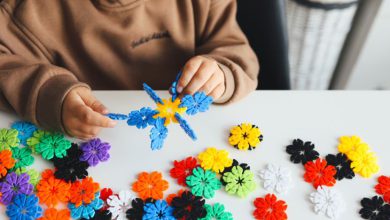Make It Up: Ideas for Imaginative Play

Make It Up: Ideas for Imaginative Play
It’s no secret that imaginative play is great for kids. But if you’ve been the parent of a toddler or preschooler longer than five minutes, you’ve probably noticed that you can run out of fun imaginative games to play with them pretty quickly.
So if you’ve got a kid at home who wants to play but no one really knows what to do, here is the blog article you’ve been looking for.
First, Imaginative Play Defined
Before we get too far, it’s important to clarify what it means when discussing imaginative play. Imaginative play is make-believe, storytelling, and fantasy. Active play is being just that — being active. So think of active play as what is traditionally done on playgrounds, whereas imaginative play (at its most advanced) is a production complete with props, costumes, and a full-blown storyline.
Don’t misunderstand: Both kinds of play are extremely important! There is no hierarchy. However, to keep things simple, this article is going to deal specifically with imaginative play.
Expectations: Pretend Play by Age
Pretend play may seem simple, but it actually requires a high-level of cognitive functioning. Think about it — you don’t expect an infant to pretend like it’s a kangaroo or an astronaut. That being said, make sure your expectations as a parent are on level with what’s actually expected for kids in your child’s age group.
- At or before 2 years old – Don’t expect a lot in terms of imaginative play before a child is 2 years old. They’ll still see the world as it is, more or less. They may lift a shoe to their ear and pretend it’s a phone, but that’s because they still can’t really tell the difference between the two.
- Between 2 & 3 years old – Play time starts getting more complex at this age. Stuffed animals and baby dolls start getting played with as if they are real. By 3 years old, most kids are able to pretend one object (a spoon) is another (a magic wand) in order to facilitate their imaginative play.
- Between 3 & 4 years old – This is imaginative play prime time. Robot battles, tea parties, sessions as a doctor, magical fairylands, and Wild West horse wrangling are all in the cards. Play sessions (if done alone) usually center around the child as the “protagonist.”
- By age 4 – Playtime has gotten even more elaborate make-believe scenarios. This is the time of imaginary friends, elaborate storylines, and multiple costume changes.
Activities for the Whole Family
Something as common as imaginative play should be easy to jumpstart, right?
Especially for toddlers, it can be hard to get creative play started. If you’re getting the “I’m bored” line from your preschooler or they’re having trouble coming up with ideas for imaginative play, here are some ideas.
- Make a prop box. Sometimes all it takes is the right toy or prop to generate creativity. Keep a box of items that can be used for all kinds of things — for example, an old phone book can be a book of recipes, a magical tome, or the foundation of a skyscraper — at the ready so your kids can jump into it when they’re ready to be creative.
- Just find a box. Don’t throw out those cardboard Amazon boxes! Boxes are the perfect playtime prop for kids. They can be imagined into just about anything a kid might need for the scene they’re playing out. If you have the space, keep a couple of boxes of varying sizes for them to use.
- Have a picnic or tea party. The quintessential toddler imaginative play setting, tea parties can involve an entire bedroom’s worth of stuffed animals or action figures. Don’t be surprised when you as the adult are invited to attend. (Make sure to RSVP … those things fill up fast.)
- Run a restaurant. Restaurants are complex businesses, so it’s the perfect thing for your child to pretend to run. Let them set the menu, “cook” the food, and invite the guests. Who knows what kind of establishment they’ll be running out of their bedroom.
- Play heroes and bad guys. This could be superheroes and villains, knights and dragons, or veterinarians who rescue baby animals — any scenario that lets your kid save the day. And of course, it’s always WAY more fun if mom or dad plays the role of the bad guy 🙂
- Schedule playdates. It’s amazing the kinds of creative scenarios kids will make up on their own. Invite a few kids over who are around the same age as yours and watch the magic of creative play happen before your very eyes.
Imaginative Play & Reading Time
Books provide your child with an amazing opportunity to explore creative play and use their imagination. Any story can spawn a new idea for imaginative play, but here are a few great books to get you started.
This is a list of picture books for toddlers and preschoolers.
- “What To Do With a Box” by Jane Yolen, illustrated by Chris Sheban
- “How To Find Gold” by Viviane Schwarz
- “Let’s Play!” by Herve Tullet, translated by Christopher Franceschelli
- “The Paper Kingdom” by Helena Ku Rhee, illustrated by Pascal Campion
- “Blankie: A Narwhal and Jelly Board Book” by Ben Clanton
This is a list of books intended for parents to read and use as resources to facilitate imaginative play.
- “Dream Rooms for Children: Imaginative Spaces To Sleep, Study, and Play” by Susanna Salk
- “Wired To Create: Unraveling the Mysteries of the Creative Mind” by Scott Barry Kaufman and Carolyn Gregoire
- “Recipes for Play: Creative Activities for Small Hands and Big Imaginations” by Rachel Sumner, photography by Ruth Mitchener
Imaginative Play & Screen Time
Not everything that’s on TV makes for good imaginative play, but here are a couple of great shows to consider if you want your kids watching what it looks like to use their imaginations.
- Bluey – This show about a family of Australian shepherds has recently taken the world by storm. The show does an incredible job of showing kids how to be creative in their play. The mom and dad in the show also provide great examples of what it looks like to engage with young children, play along, and facilitate imaginative time. If you need ideas for games to play with your young one, every 8-minute episode is an at-home activity waiting to happen.
- Sesame Street – The decades-long gold standard in children’s television gets that status partly because of the way it stimulates childrens’ imaginations. Whether it’s Elmo pretending to be a farmer or Cookie Monster pretending to be a spy, Sesame Street can give kids all kinds of ideas to be creative while simultaneously teaching them an important life skill or lesson.
The right mix of active play and imaginative play is a recipe for success when it comes to raising kids. And don’t worry too much if your child seems to prefer one to the other. Some kids are a lot more active, others more imaginative. As long as you give them the opportunity to engage in both (and play along as much as you can!), they’ll be just fine.
Now get out there and slay some dragons!
Check out some of our additional parenting tips and tricks at littlesunshine.com/blog/.
The Surprising Benefits of Imaginative Play
Let Kid’s Play …. in the Dirt
Teaching Your Child to Cope with Bullies





